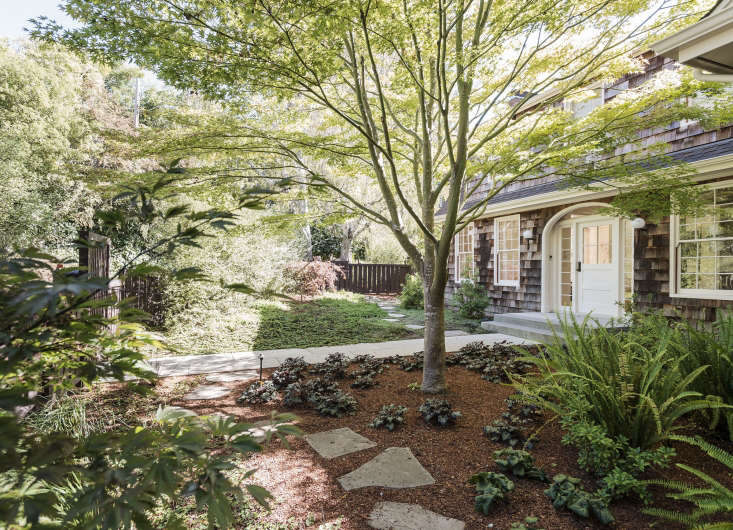If you’re thinking of buying a house, don’t overlook the landscape. In many parts of the country, the property you’re buying could be worth even more than the house itself. And if you have plans to put in a garden or install outbuildings, you need to take a good look at the land surrounding the house.
As a homebuyer, you probably already know what to inspect inside a house (do the faucets all work?) and on the facade (how about those rain gutters?). But what should you look for in the surrounding property?
For advice, we talked to experts on both the East and West coasts: a seasoned realtor in California’s Marin County and an equally seasoned landscape designer on Cape Cod. Here are 10 tips from realtor Kathleen Clifford and garden designer Tim Callis:
1. Follow your realtor’s advice on inspections.

Typically, buyers hire a home inspector to take a close look at the structure of the house. If the inspector finds things that need attention, you can decide not to buy or you can use the information to renegotiate the purchase price, perhaps reducing it by the amount required to make the necessary repairs or improvements.
Inspections can work the same way for the condition of the property. A savvy broker who is aware of potential pitfalls will advise you to bring in a number of other inspectors to assess the property, depending on the lay of the land. “I sometimes recommend as many as five or six inspectors,” says Kathleen Clifford, a realtor who’s worked in California’s Marin County since 2001. Reach her at Making Marin Home. You’ll learn more in the tips that follow.
2. Have an arborist inspect the trees.

“If there are big trees on the property, you want to make sure they’re sound,” says Tim Callis, a garden designer in Cape Cod, Mass., whose work is featured in several chapters in our Gardenista book. “That’s especially true of trees that are looming over the house in a threatening way.”
When Tim bought his own property in Wellfleet, Massachusetts, he had to take out about 50 Norway maples. “A single Norway maple can be pretty, but they’re horrible non-native invasives—they seed voraciously and take over,” he says. He also removed black locust trees from the property. “Since they don’t have much of a root system, they blow over easily in high winds. An arborist told me a black locust is the same weight as a steel I-beam—it’s hard, heavy wood. You don’t want that close to your home.”

Besides the risk to the house, a licensed arborist can assess the age and condition of the trees. “A big tree, like the redwoods and sequoias we have here, is expensive to remove,” says Kathleen. “Plus, people don’t want to lose beautiful trees—they’re part of the ambience when you’re selling the house. So you’d like to know if the tree is healthy now and if it will stay healthy in the foreseeable future.”
And if you’re hoping for a low-maintenance yard, you probably don’t want a lot of deciduous trees. That is, trees that drop their leaves in fall—leaves you have to rake (or hire someone to rake).
3. Make sure the land is free of poisonous and invasive plants.

When Kathleen bought her first property after having kids, she found oleander growing there. “At the time I had no idea that oleander is toxic, so it shouldn’t be around little kids,” she says. Worse, when clearing brush her husband found out the hard way that there was also poison oak—and that he was highly allergic to it.
“Luckily, arborists don’t just look at trees; they look at plants as well,” says Kathleen. She usually calls an arborist for a specific tree question, but has found that once they’re on the site they’ll point out everything, since they’re able to identify many kinds of plants.
Tim Callis has similar advice about invasive plants. “We have problems with non-native invasive plants on the Cape,” he says. “If a yard has been maintained, you probably won’t find any. But if there’s some wild space on the edge of the property, there could be, say, some oriental bittersweet. And if it’s not eradicated, it can easily invade the rest of the property, crowding out the plants you want to grow.”
Tim also warns against rosa multiflora, or Japanese rose. “It’s very pretty, but there’s nothing to keep it in check. It will climb up into your trees and eventually choke them to death—or add extra weight that can bring the tree down in a big wind storm.” (The South, of course, must deal with the scourge of kudzu: see Killer Kudzu: 5 Ways to Defeat the Vine That’s Eating the Eastern Seaboard.)
4. Look for damage where you see climbing plants.

“It’s a nice romantic touch when a house is covered with ivy, wisteria, or climbing hydrangea,” says Tim. But as pretty as those climbing plants are, they can damage the facade—especially if it’s wood shingle or clapboard, which is common on the Cape.
Tim suggests you pull some vines away and press the surface with your hands to check the condition of what’s underneath. Climbers can harm even stucco and brick, and can also cause problems by getting in under the eaves.
Adds Kathleen: “Inspectors will always tell you to take down vines. They hate to see any kind of vegetation growing on a building, as it promotes deterioration.”
5. Avoid drainage pains.

The home inspector is likely to point out failings in this area. Still, Tim advises you to make sure you know whether the land drains properly, especially in an area prone to flooding. Could heavy rains turn the yard into a swamp? If the land slopes toward the foundation, will storms cause water to leak into the house?
“Depending on the site, I typically suggest that a prospective buyer bring in a drainage inspector to find out where water goes,” says Kathleen. “You might find that it’s draining onto a neighbor’s property, and that could be a problem down the road.” If the house is on a steep slope, Kathleen also feels you should ask a soils engineer or structural engineer to confirm that the building is properly braced for the hillside.
6. If there are shared features, find out who’s responsible.

Find out what you have in common with your neighbors—does the property share a fence, a walkway, or a driveway? If so, it’s important to learn who’s responsible for repairs and upkeep, and if there’s a written agreement. Fences are usually shared—you know the adage about good fences making good neighbors. If the existing fence doesn’t happen to meet community standards, you might find yourself having to share half the cost of an expensive replacement job.

“And even if a fence looks okay, make sure that the posts themselves are solid,” says Tim. Don’t be afraid to go over and give them a tug.
7. Meet the neighbors.

Kathleen warns that getting to know the neighbors should be a priority—before you buy the place. “If you have great neighbors, you’ll be able to approach them up front about who’ll maintain, fix, or replace the things you share on the property. But if the neighbors are cantankerous and your fence blows down in a storm, you might be the one paying for it.” Bad news about neighbors might dampen your interest in buying a property.
8. Respect the boundaries.

In California, according to Kathleen, there often are no surveys when houses change hands. “So we may not know about any easements or encroachments—say, if a fence is crossing somebody else’s property line. If you’re planning to build a deck or put in a swimming pool, you’ll need to make sure you’re doing it on your own property.” It might be wise to have the property surveyed before you buy, especially if you’re thinking of making changes.
9. Suss out insurance issues.

These days, getting homeowner’s insurance isn’t always easy, says Kathleen. “Sometimes the insurers will do a drive-by or look at Google photographs to see a property from the air. If there’s a lot of foliage on the property, and/or it’s up in the hills—that is, hard for fire crews to access—you may only be able to get insurance from one company, and it can be pricey.”
In Marin County, says Kathleen, the fire department recommends keeping the perimeter of a structure clear of brush and vegetation to make it easier to save the building in the event of a catastrophic fire. When she’s showing a property, she calls insurance companies to ask if they’re willing to issue a policy for the property at that address—and if they are, what the rate would be.
10. Find out the community rules.

Other regulations can affect what you can do with your space. “Even if the place you’re looking at isn’t in a condo or townhouse community, there could be a homeowners’ association,” says Kathleen. “It might specify not just the color you can paint the front door, but also the kind of landscaping you’re allowed to have.” There could even be view ordinances that stop you from building something that blocks your neighbors’ view. But those rules work both ways: They can also prevent your neighbors from doing the same to you.
See more tips in our curated design guides to Hardscape 101 including Decks & Patios 101, Retaining Walls 101, and Exteriors & Facades 101. For new homebuyers’ ideas to transform a garden on a budget, see:
- Landscape on a Budget: The $250 Instant Rose Garden
- Everything You Need to Know About Building a Patio
- Landscape on a Budget: 10 Quick Fixes to Add Personality to the Average Garden
- Before & After: A $5,000 Garden Makeover in St. Augustine, Florida








Have a Question or Comment About This Post?
Join the conversation